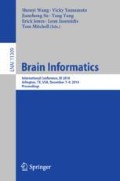Abstract
Does word meaning change according to the context? Although this hypothesis has existed for a long time, only recently it has become possible to test it based on neuroimaging. Embodiment theories of knowledge representation suggest that word meaning consist of a collection of attributes defined in terms of various neural systems. This approach represents an unlimited number of objects through weighted attributes and the weights may change in context. This paper aims at quantifying such dynamic meanings using computational modeling. A neural network is trained with backpropagation to map attribute-based representations to fMRI images of subjects reading everyday sentences. Backpropagation is then extended to the features, demonstrating how they change in different sentence contexts for the same word. Indeed, statistically significant changes occurred across similar contexts and across different subjects, quantifying for the first time how attribute weightings for the same word are modified by context. Such dynamic representations of meaning could be used in future natural language processing systems, allowing them to mirror human performance more accurately.
Access this chapter
Tax calculation will be finalised at checkout
Purchases are for personal use only
References
Regier, T.: The Human Semantic Potential. MIT Press, Cambridge (1996)
Landau, B., Smith, L., Jones, S.: Object perception and object naming in early development. Trends Cogn. Sci. 27, 19–24 (1998)
Barsalou, L.W.: Grounded cognition. Annl. Rev. Psyc. 59, 617–845 (2008)
Binder, J.R., Desai, R.H., Graves, W.W., Conant, L.L.: Where is the semantic system? A critical review of 120 neuroimaging studies. Cereb. Cortex 19, 2767–2769 (2009)
Binder, J.R., Desai, R.H.: The neurobiology of semantic memory. Trends Cogn. Sci. 15(11), 527–536 (2011)
Binder, J.R., et al.: Toward a brain-based Comp. Sem. Cogn. Neuropsychol. 33(3–4), 130–174 (2016)
Binder, J.R.: In defense of abstract conceptual representations. Psychon. Bull. Rev. 23, 1096–1108 (2016)
Pecher, D., Zeelenberg, R., Barsalou, L.W.: Sensorimotors simulations underlie conceptual representations: modality-specific effects of prior activation. Psychon. Bull. Rev. 11, 164–167 (2004)
Aguirre-Celis, N., Miikkulainen R.: From words to sentences & back: characterizing context-dependent meaning rep in the brain. In: Proceedings of the 39th Annual Meeting of the Cognitive Science Society, London, UK, pp. 1513–1518 (2017)
Glasgow, K., Roos, M., Haufler, A. J., Chevillet, M., A., Wolmetz, M.: Evaluating semantic models with word-sentence relatedness. arXiv:1603.07253 (2016)
Anderson, A.J., et al.: Perdicting Neural activity patterns associated with sentences using neurobiologically motivated model of semantic representation. Cereb. Cortex 1–17 (2016). https://doi.org/10.1093/cercor/bhw240
Burgess, C.: From simple associations to the building blocks of language: modeling meaning with HAL. Behav. Res. Methods Inst. Com. 30, 188–198 (1998)
Landauer, T.K., Dumais, S.T.: A solution to plato’s problem: the latent semantic analysis theory. Psychol. Rev. 104, 211–240 (1997)
Vinyals, O., Toshev, A., Bengio, S., Erham, D.: Show and tell: a new image caption generator. arXiv:1506.03134v2 (2015)
Miikkulainen, R., Dyer, M.G.: Natural language processing with modular PDP networks and distributed lexicon. Cogn. Sci. 15, 343–399 (1991)
Estes, Z., Golonka, S., Jones, L.L.: Thematic thinking: the apprehension and consequences of thematic relations. Psychol. Learn. Motiv. 54, 249–294 (2011)
Anderson, A.J., et al.: Multiple regions of a cortical network commonly encode the meaning of words in multiple grammatical positions of read sentences. Cereb. Cortex 1–16 (2018). https://doi.org/10.1093/cercor/bhy110
Mitchell, J., Lapata, M.: Composition in distributional models of semantics. Cogn. Sci. 38(8), 1388–1439 (2010). https://doi.org/10.1111/j.1551-6709.2010.01106.x
Acknowledgments
We would like to thank Jeffery Binder (Medical College of Wisconsin), Rajeev Raizada and Andrew Anderson (University of Rochester), Mario Aguilar and Patrick Connolly (Teledyne Scientific Company) for providing this data and insight for this research. This work was supported in part by IARPA-FA8650-14-C-7357 and by NIH 1U01DC014922 grants.
Author information
Authors and Affiliations
Corresponding author
Editor information
Editors and Affiliations
Rights and permissions
Copyright information
© 2018 Springer Nature Switzerland AG
About this paper
Cite this paper
Aguirre-Celis, N., Miikkulainen, R. (2018). Combining fMRI Data and Neural Networks to Quantify Contextual Effects in the Brain. In: Wang, S., et al. Brain Informatics. BI 2018. Lecture Notes in Computer Science(), vol 11309. Springer, Cham. https://doi.org/10.1007/978-3-030-05587-5_13
Download citation
DOI: https://doi.org/10.1007/978-3-030-05587-5_13
Published:
Publisher Name: Springer, Cham
Print ISBN: 978-3-030-05586-8
Online ISBN: 978-3-030-05587-5
eBook Packages: Computer ScienceComputer Science (R0)

